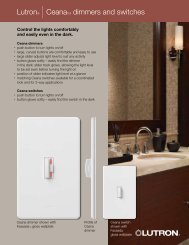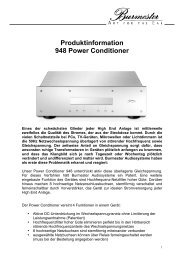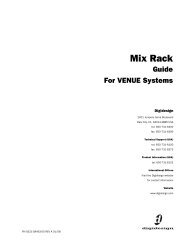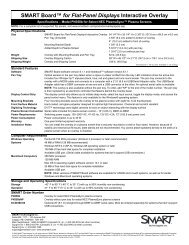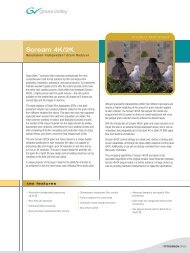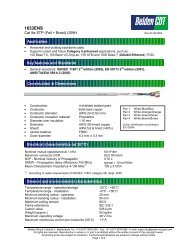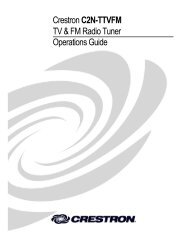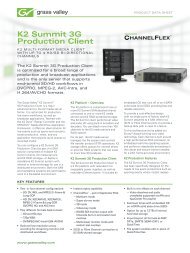Quickfly Operating Manual - Meyer Sound Laboratories Inc.
Quickfly Operating Manual - Meyer Sound Laboratories Inc.
Quickfly Operating Manual - Meyer Sound Laboratories Inc.
Create successful ePaper yourself
Turn your PDF publications into a flip-book with our unique Google optimized e-Paper software.
United States. All working loads are based on a 5:1 safety<br />
factor.<br />
However, as noted above, there are wide variations internationally<br />
in the regulations and practices applying to suspension<br />
of sound systems in public places. Although regulations<br />
in the USA are generally among the most stringent,<br />
safety codes may be even stricter in a few localities (such<br />
as those highly prone to earthquakes). In addition, applicable<br />
safety codes are open to interpretation: government<br />
officials in one location may have a stricter interpretation<br />
than officials in other locations, even when operating under<br />
the same regulations and in the same legal jurisdiction.<br />
Consequently, users of QuickFly should be prepared to take<br />
additional safety assurance measures beyond those outlined<br />
in this manual. In all cases, it is the sole and express<br />
responsibility of the user to make certain that any <strong>Meyer</strong><br />
<strong>Sound</strong> loudspeaker system is suspended in accordance with<br />
all applicable national, state/provincial and local regulations.<br />
3.5 ADVISORY NOTE: SAFETY RESPONSIBILITIES OPEN TO<br />
INTERPRETATION<br />
In most touring applications of rigging systems, the touring<br />
sound provider is normally responsible only for ensuring<br />
the safety of the suspension system below the attachment<br />
point. The safety and suitability of the attachment<br />
point is generally seen as the responsibility of the venue<br />
owner or operator. However, this distinction ("above the<br />
hook" versus "below the hook") may be open to interpretation.<br />
Touring system operators would be well advised to<br />
double check to make certain that attachment points are<br />
approved and suitably load rated, and that the points used<br />
are those identified as such by the venue owner or operator.<br />
As an extra precaution, careful inspection of the<br />
attachment points is advised before flying, particularly in<br />
older venues or those hosting frequent events using large<br />
sound and lighting systems. In any case, <strong>Meyer</strong> <strong>Sound</strong><br />
QuickFly systems are intended only for suspension from<br />
approved rigging points, each known to have ample SWL<br />
margins for the system components suspended below them.<br />
3.6 INSPECTION AND MAINTENANCE<br />
The <strong>Meyer</strong> <strong>Sound</strong> QuickFly system is an assembly of<br />
mechanical devices, and is therefore subject to wear and<br />
tear over prolonged use, as well as damage from corrosive<br />
agents, extreme impact or inappropriate use.<br />
Because of the safety issues involved, users must adopt<br />
and adhere to a schedule of regular inspection and maintenance.<br />
In touring applications, key components must be<br />
inspected before each use. Such inspection will include<br />
examination of all load-bearing components for any sign of<br />
undue wear, twisting, buckling, cracking, rusting or other<br />
corrosion. In regard to rust and corrosion, all main components<br />
of the QuickFly system are either protected by an<br />
5<br />
exterior coating or are made from stainless steel, which is<br />
impervious to rust and resistant to most corrosive fluids.<br />
Nevertheless, normal use and shipping vibrations can wear<br />
through the protective coatings, and extremely corrosive<br />
fluids (such as battery acid) can cause severe damage with<br />
prolonged exposure even to protected parts. Particular<br />
attention should be given to screws, bolts and other fasteners<br />
to make certain the fittings are tight and secure.<br />
Metal seams and welds should be examined for any sign of<br />
separation or deformation. <strong>Meyer</strong> <strong>Sound</strong> strongly recommends<br />
that written documentation be maintained on each<br />
QuickFly system, noting date of inspection, name of<br />
inspector, points of system checked, and any anomalies<br />
discovered.<br />
In addition to routine checks on the road for touring systems,<br />
<strong>Meyer</strong> <strong>Sound</strong> also recommends a careful, comprehensive<br />
system examination and testing "at home" in the<br />
warehouse or other appropriate location at regular intervals.<br />
At this time, each component should be carefully<br />
inspected under ideal lighting conditions, and then the<br />
entire system should be flown as used for a final comprehensive<br />
check.<br />
If any anomalies or defects are discovered that could possibly<br />
affect the safety or integrity of the system, any<br />
affected parts or subsystems should be replaced in their<br />
entirety before that part of the system is flown again. (See<br />
3.7 below.)<br />
3.7 REPLACEMENT PARTS<br />
Any component found to be defective, or any safety-related<br />
component you even suspect might be defective, should be<br />
replaced with the equivalent, approved part. In the case of<br />
parts specific to the QuickFly system, these parts should be<br />
ordered directly from <strong>Meyer</strong> <strong>Sound</strong>. No attempt should be<br />
made to substitute what appear to be equivalent or "mostly<br />
the same" generic replacements.<br />
Many other parts used in a QuickFly system will be identical<br />
to those used in other L-Track applications. To the best<br />
of our knowledge, all suppliers of L-Track components are<br />
reputable and their products reliable. However, <strong>Meyer</strong><br />
<strong>Sound</strong> has no way of assuring the quality of products made<br />
by these various suppliers. Therefore, <strong>Meyer</strong> <strong>Sound</strong> cannot<br />
be held responsible for any problems caused by components<br />
that were not supplied by <strong>Meyer</strong> <strong>Sound</strong>.<br />
3.8 TRAINING<br />
Considering its sophistication and flexibility, the QuickFly system<br />
is relatively straightforward and easy to use. Nevertheless,<br />
there are key points of assembly, rigging and flying that must<br />
be fully mastered before a system is flown. Users should read<br />
this manual in its entirety before attempting to deploy a<br />
QuickFly system. (You may make additional photocopies of<br />
this manual as necessary for in-house training purposes only;<br />
please do not distribute outside your company.)




